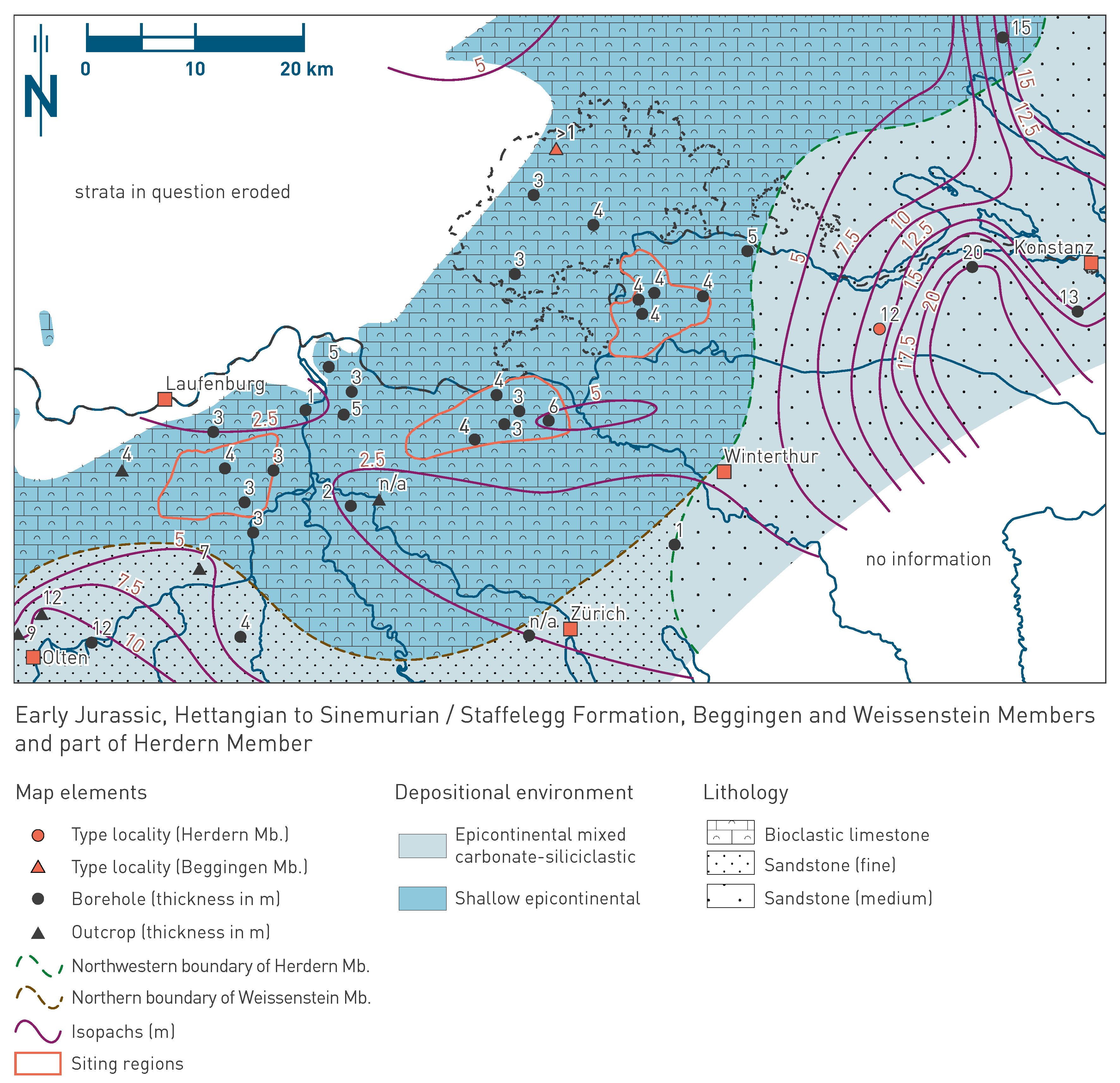The Early Jurassic Staffelegg Formation was deposited in a shallow epicontinental sea in a subtropical to tropical climate. The Early Jurassic was characterised by a N-S-directed extension during the opening of the Piemont – Liguria Ocean (Chapter 3). The base of the Staffelegg Formation is a major unconformity (Section 4.2.4). In nearly 30 million years only 35 – 45 m of sedimentary rocks are preserved; the overall sedimentation rates are thus low to very low (Fig. 4‑4, Fig. 4‑5, Fig. 4‑6). The Early Jurassic is globally characterised by a marine transgression (Haq 2018). The associated deposits in the study area are related to phases of strong condensation, reworking, hiatuses and some intermittent episodes with relatively elevated sedimentation rates (Reisdorf et al. 2011, Kiefer et al. 2015). To the east and south, the epicontinental sea was bordered by the Vindelician Land and its promontory, the Alemannic Land, which successively became an island because of continuous lowering and flooding. These topographically high zones were potential sources for siliciclastic input (Trümpy 1959, Jordan 1983). Overall, the depositional environment appears to have evolved similarly over the entire study area. Lateral facies variability points to the presence of a smaller-scale palaeo-relief on the sea floor and different bottom current conditions. The depositional evolution of the Staffelegg Formation is subdivided here into four time intervals:
The first time interval (201.4_Rha_100 to 199.5_Het_100, mostly Hettangian) approximately corresponds to the strata of the Schambelen Member. This time interval represents the first fully marine depositional environment after the mostly terrestrial Triassic Klettgau Formation. The sedimentary rocks reflect phases with elevated siliciclastic input. More proximal settings with coastal sands of the Alemannic Land and the Vindelician Land characterise areas towards the east and are inferred to exist south of the siting regions.
The second time interval (199.5_Het_100 to 192.9_Sin_200, mostly lower part of Sinemurian) mainly corresponds to the Beggingen Member. During this time interval, calcareous sedimentation dominated (Fig. 4‑26). Evidence for condensation such as hardgrounds, iron-oolites and phosphatic nodules is common, supporting the notion of very low sedimentation rates. Sedimentary structures and fossils document the past existence of a shallow, partly very shallow marine setting with potential, localised, short-term emergence (Jordan 1983, Wetzel et al. 1993, Reisdorf & Wetzel 2018), with high current activity and diverse marine fauna.
The third time interval (192.9_Sin_200 to 192.9_Sin_100, within the upper part of the Sinemurian) mainly corresponds to the Frick Member. The depositional environment was characterised by fine-grained siliciclastic input from the Alemannic Land and the Vindelician Land (similar situation as shown in Fig. 3‑8). During the deposition of the Frick Member sedimentation rates temporarily increased.
The fourth time interval (192.9_Sin_100 to 174.7_Toa_100, uppermost part of the Sinemurian to end of the Toarcian) corresponds to the time interval during which the Grünschholz up to the Gross Wolf Members were deposited. The first part of this time interval, at the end of the Sinemurian and the Pliensbachian, is again characterised by the deposition of condensed successions indicated by phosphatic hardgrounds and reworked nodules (Grünschholz, Breitenmatt and Rickenbach Members). After a hiatus, the depositional environment was characterised by sedimentation rich in clay minerals and organic material during the Early Toarcian (Rietheim Member). This depositional environment has been extensively studied in Southern Germany, including famous fossil sites such as Holzmaden (Posidonienschiefer Formation). A shallow marine, warm, partly hypersaline and oxygen-poor environment can be reconstructed for the deposition during this interval (Riegraf 1985). Röhl & Schmid-Röhl (2005) favoured a depositional model involving a slow increase of the sea level in a "silled basin" that resulted in stagnant conditions. Alternative depositional models were also discussed. After a further hiatus with pronounced erosion, a phase of condensed deposition in a shallow marine, distal setting with an increased calcareous content is reflected by the Gross Wolf Member.

Fig. 4‑26:Map of depositional environments during the Hettangian to Sinemurian preserved in the Beggingen and Weissenstein Members and part of the Herdern Member
Refer to Fig. 4‑3 for a schematic representation of depositional environments. The north arrow refers to present-day geographic north.

